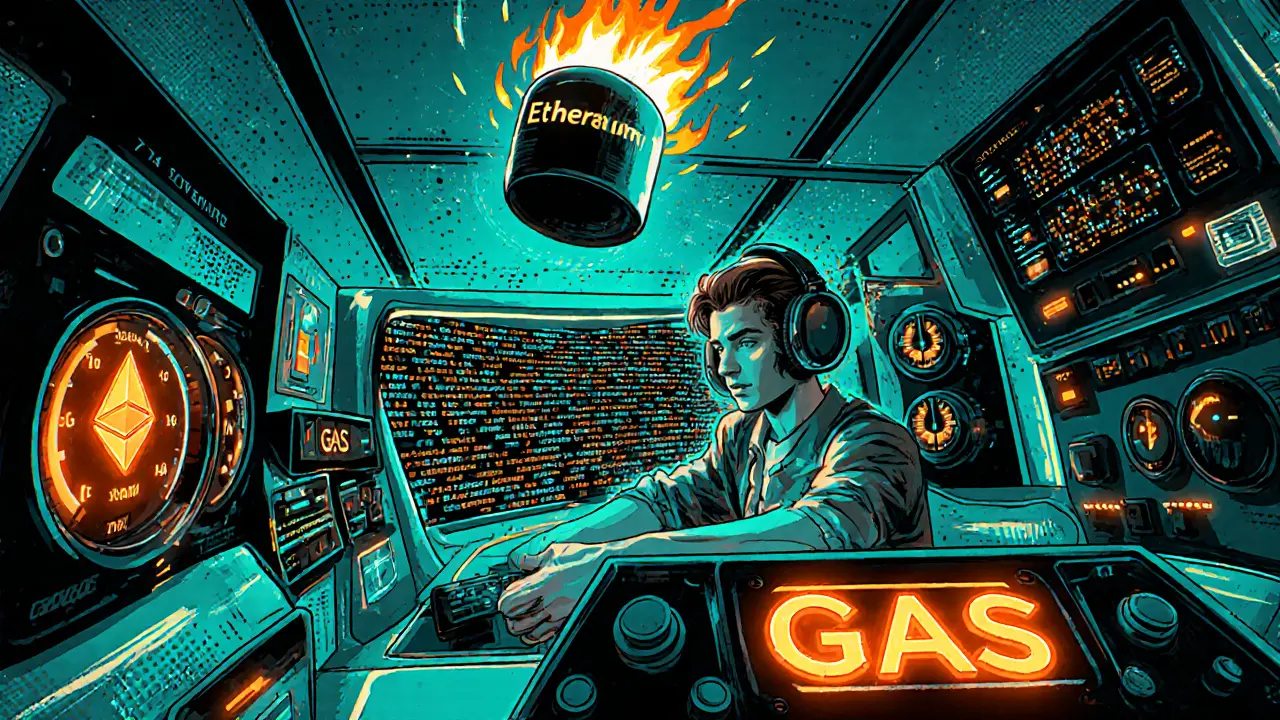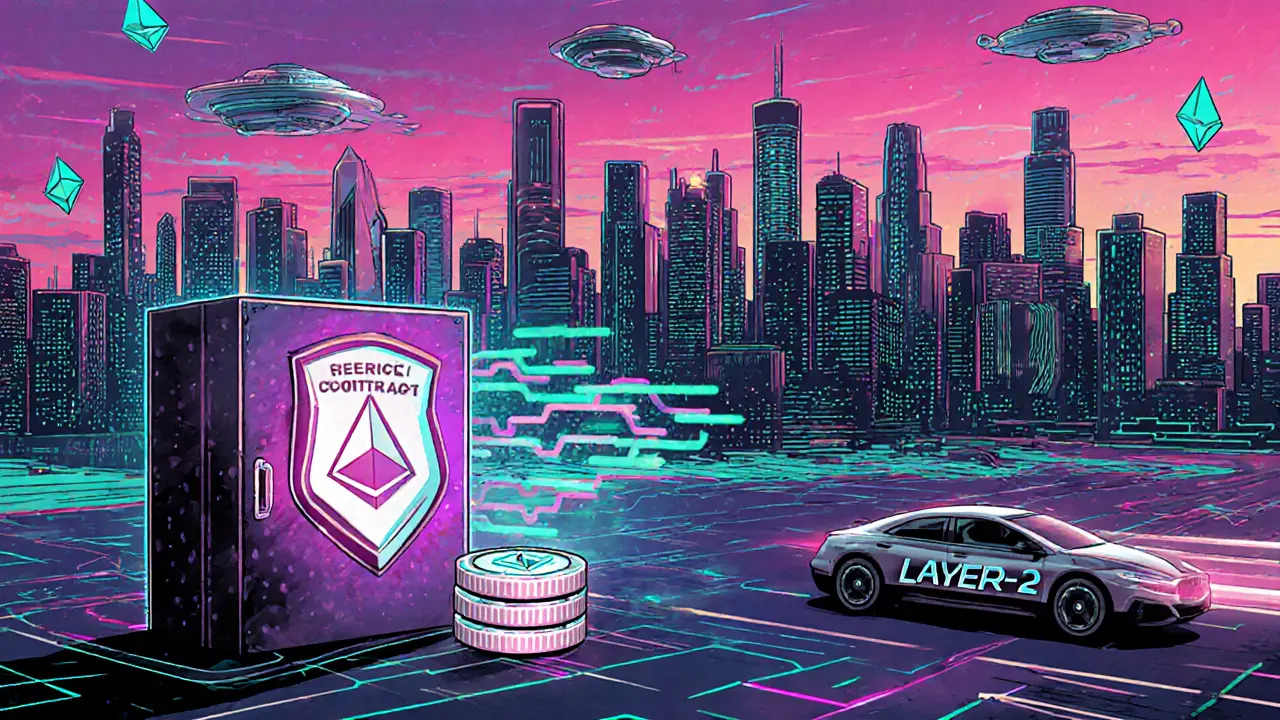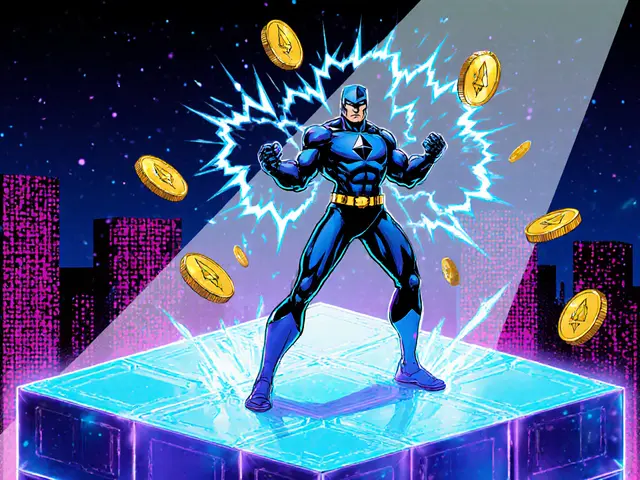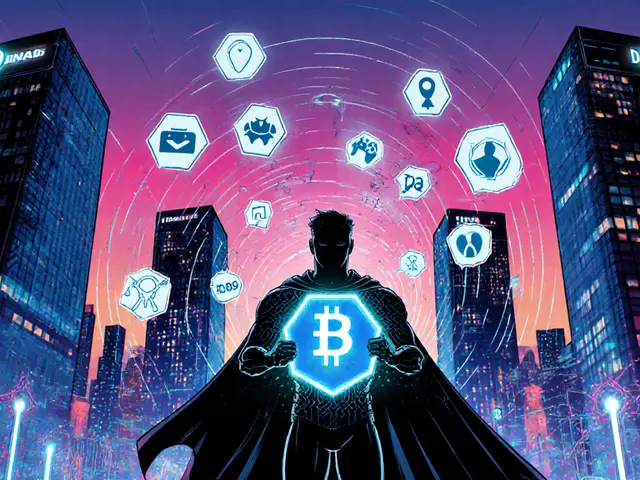Ethereum Smart Contract Features Explorer
Smart Contract Overview
Ethereum smart contracts are self-executing programs stored on the blockchain that automatically execute predefined conditions. They operate within the Ethereum Virtual Machine (EVM) and enable trustless interactions without intermediaries.
EVM
Executes contract code in a secure, isolated environment
Gas
Computational fuel that powers transactions
Oracles
Bridge blockchain with real-world data
Ever wondered how a piece of code can move money around without a bank, a lawyer, or even a middle‑man? That’s exactly what Ethereum smart contracts do: they are self‑executing programs that live on the blockchain and trigger actions the moment predefined conditions are met.
Ethereum is a public, permissionless blockchain that enables developers to run code in a trust‑less environment. The platform’s real differentiator is its ability to host smart contracts - autonomous contracts that automatically enforce the rules written into them. In this guide we’ll walk through the mechanics, the tools, the limits, and the real‑world use cases you need to know.
- Smart contracts are "if‑then" programs stored on the blockchain.
- They run inside the Ethereum Virtual Machine (EVM), a sandboxed execution engine.
- Developers write contracts in Solidity or Vyper, then compile to bytecode.
- Deploying a contract costs gas, the fuel that powers every transaction.
- Oracles bridge the on‑chain world with off‑chain data, solving a key limitation.
What Makes a Smart Contract Tick?
At its core, a smart contract is a collection of functions and state variables stored at a unique address on the blockchain. When a transaction calls one of those functions, the EVM checks every condition - think of a digital "if/when…then" statement. If the condition passes, the code runs; if not, the transaction reverts and any state changes are discarded.
Because the EVM is deterministic, every node on the network reaches the same result, guaranteeing that the contract’s outcome cannot be tampered with after the fact.
The Execution Playground: Ethereum Virtual Machine
The Ethereum Virtual Machine (EVM) provides a uniform environment for contract code, regardless of the underlying hardware. It interprets bytecode - a low‑level representation generated by the Solidity or Vyper compiler - and enforces gas limits to prevent infinite loops.
Special global variables like msg.sender (the address that initiated the call) and block.timestamp (the current block’s time) let contracts read context without exposing private data.
Writing Contracts: Solidity vs. Vyper
| Feature | Solidity | Vyper |
|---|---|---|
| Syntax style | JavaScript‑like | Python‑like |
| Maturity | Most widely adopted, extensive tooling | Newer, smaller ecosystem |
| Safety features | Supports inheritance, modifiers | Deliberately limited (no class inheritance) |
| Compiler output | Optimized bytecode, multiple optimizer levels | Cleaner bytecode, focuses on auditability |
| Community support | Large community, many libraries (OpenZeppelin, etc.) | Smaller, but growing academic interest |
Both languages compile to the same EVM bytecode, so you can choose the one that fits your team’s skillset. Solidity dominates DeFi and NFT projects, while Vyper is popular for contracts where simplicity and security are paramount.
Deploying a Contract: From Code to Address
Deployment itself is a transaction. You package the compiled bytecode, attach a gas limit, and sign it with an account that holds enough ETH to cover the fee. The network then validates the transaction, stores the bytecode at a fresh address, and returns that address in the receipt.
Popular tools include:
- Remix IDE - a web‑based editor that compiles and deploys with a single click.
- Hardhat - a Node.js framework for automated testing and scripted deployments.
- Foundry - a fast, Rust‑based toolkit favored by power users.
When you target a testnet (e.g., Sepolia) via MetaMask, you can experiment without spending real ETH. Once confident, you broadcast the same transaction to the Ethereum mainnet.
Gas: The Fuel That Powers Execution
Every step the EVM takes consumes gas, a unit that quantifies computational effort. Simple storage reads cost about 200 gas, while a full contract deployment can require upwards of 1million gas, translating to a few dollars at today’s rates. Understanding gas helps you write cost‑efficient contracts - for example, using require() early in a function to avoid expensive state changes if inputs are invalid.

Composability: Contracts Calling Contracts
Because all contracts are publicly addressable, one contract can invoke functions on another. This composability enables complex ecosystems such as decentralized exchanges (Uniswap) that route trades through multiple liquidity pools, or DAOs that execute governance proposals by calling treasury contracts.
Even a contract can deploy a new contract from within its code - a pattern known as “factory contracts”. This is how token standards like ERC‑20 and ERC‑721 are instantiated at scale.
Token Standards: ERC‑20 and ERC‑721
The ERC‑20 token standard defines a common set of functions (balanceOf, transfer, approve, etc.) that make any compliant token interchangeable across wallets and exchanges. In contrast, the ERC‑721 standard represents unique, non‑fungible assets - the backbone of most NFT projects.
Both standards are just interfaces; the underlying smart contract implements the logic that enforces ownership, transfer rules, and optional metadata.
Bridging On‑Chain and Off‑Chain: Oracles
Smart contracts can’t fetch external data on their own - that would break consensus. Oracles act as trusted data providers that push information (price feeds, weather data, sports results) onto the blockchain. Chainlink is the most widely used decentralized oracle network, allowing contracts to verify data from multiple sources before acting.
Limitations You Should Know
- No native off‑chain access - you must rely on oracles, which add complexity and cost.
- Contract size cap - the bytecode cannot exceed 24KB; larger projects use design patterns like the Diamond Pattern to split logic across multiple contracts.
- Gas volatility - during network congestion, fees can spike dramatically, affecting usability.
- Immutability - once deployed, code can’t be changed. Upgradability requires proxy patterns and careful governance.
Security Best Practices
Because bugs are irreversible, the community follows a checklist:
- Use
require()statements to validate inputs early. - Leverage well‑audited libraries (e.g., OpenZeppelin) for common tasks like ERC‑20 implementation.
- Run unit tests on local networks, then integration tests on public testnets.
- Consider formal verification for high‑value contracts (e.g., DeFi vaults).
- Engage third‑party auditors before mainnet launch.
Future Outlook
Ethereum’s roadmap - including the Shanghai upgrade and continued layer‑2 scaling (Optimism, Arbitrum, zkSync) - aims to lower gas costs and improve throughput. As these solutions mature, smart contracts will become even more practical for everyday applications, from micro‑insurance to supply‑chain provenance.

Frequently Asked Questions
Can anyone deploy a smart contract on Ethereum?
Yes. As long as you have an Ethereum address with enough ETH to cover the gas fee, you can publish a contract to any network (testnet or mainnet).
What is the difference between a contract’s address and a user’s address?
A user address is controlled by a private key; a contract address is controlled by its code. The contract’s balance can change only when its functions are called.
Why do smart contracts cost gas even when they only read data?
Reading data still requires the EVM to execute a function, which consumes computational steps. “View” functions are free when called off‑chain, but on‑chain calls still need gas.
How do oracles keep data trustworthy?
Decentralized oracle networks pull data from multiple sources, aggregate it, and provide cryptographic proofs. This reduces reliance on a single point of failure.
What’s the best way to test a contract before mainnet launch?
Start with unit tests in Hardhat or Foundry, then deploy to a public testnet like Sepolia using MetaMask. Run the same transaction flow you plan for mainnet to catch gas and compatibility issues.



Ciaran Byrne
August 19, 2025 AT 06:10Just a heads‑up: Solidity basics are a solid starter.
Brooklyn O'Neill
August 23, 2025 AT 21:17I found the section on gas mechanics really helpful, especially the breakdown of common costs. It made me realize how to optimise my contract functions early on. Using require() statements upfront can save a lot of gas. Happy learning, everyone!
Patrick MANCLIÈRE
August 28, 2025 AT 12:24Anyone new to the EVM should check out the official yellow paper – it demystifies the deterministic execution model. Pair that with the OpenZeppelin library and you’ve got a solid foundation. The docs also cover how msg.sender and block.timestamp work under the hood.
Carthach Ó Maonaigh
September 2, 2025 AT 03:30Yo, that gas section hit me like a caffeine rush. If you’re not capping your loops, you’ll watch your ETH burn faster than a cheap fireworks show. Remember, each storage write is pricey, so batch updates when you can. Also, sprinkle some unchecked math only if you know what you’re doing. Keep it tight.
Marie-Pier Horth
September 6, 2025 AT 18:37One might argue that smart contracts are the modern embodiment of Faustian bargains, promising autonomy while binding us to immutable code. Yet the very immutability reflects a deeper philosophical commitment to trustlessness. In this sense, each deployment is a solemn pact with the blockchain collective.
Gregg Woodhouse
September 11, 2025 AT 09:44meh, the guide is okay but could use less fluff. i’m just here for the code snippets.
F Yong
September 16, 2025 AT 00:50Sure, the EVM is brilliant, but have you considered how every oracle is a potential backdoor? One compromised feed could sway entire DeFi protocols. Just a thought.
Sara Jane Breault
September 20, 2025 AT 15:57Great overview! Remember to test on Sepolia before you go live.
Noel Lees
September 25, 2025 AT 07:04Loved the breakdown of token standards – really clear! 😊
Raphael Tomasetti
September 29, 2025 AT 22:10The discussion on composability touches on the core protocol stack – immutable contracts interacting via ABI calls. This is where decentralized finance achieves its synergy. Leveraging interfaces reduces bytecode bloat while preserving type safety.
Jenny Simpson
October 4, 2025 AT 13:17Honestly, I think the whole smart‑contract hype is overblown. Most projects just re‑bundle old ideas with flashier branding.
Ron Hunsberger
October 9, 2025 AT 04:24Don’t forget to run static analysis tools like Slither before deployment. They catch re‑entrancy patterns that are easy to miss in manual review.
Anurag Sinha
October 13, 2025 AT 19:30What if the whole blockchain is a simulation? Oracles could be the agents feeding us fabricated reality. Just saying, stay sceptical.
Raj Dixit
October 18, 2025 AT 10:37Our nation needs to lead the way in blockchain sovereignty. Foreign developers can’t dictate our smart‑contract standards. Adopt home‑grown frameworks ASAP.
Darrin Budzak
October 23, 2025 AT 01:44Nice guide, especially the part about testing on public testnets.
karyn brown
October 27, 2025 AT 16:50Seriously, if you’re not using OpenZeppelin, you’re practically inviting disaster. 🙄💥
Megan King
November 1, 2025 AT 07:57Keep experimenting with Foundry – it speeds up compilation dramatically.
Nilesh Parghi
November 5, 2025 AT 23:04From a philosophical standpoint, each contract is a micro‑society governed by code. The elegance lies in its self‑enforcement, free from external arbitration.
Keith Cotterill
November 10, 2025 AT 14:10One must recognize that the superficial treatment of smart contracts in mass‑media discourse belies a profound shift in epistemic authority. When Solidity code supplants traditional legal contracts, we witness a redefinition of sovereignty itself. The immutable ledger, immutable as the tenets of a Platonic ideal, offers a kind of hyper‑rationality that is both exhilarating and terrifying. Yet this very hyper‑rationality demands an unprecedented level of diligence; a single mis‑calculated storage write becomes a gauntlet thrown at the very notion of trust. In practice, developers must internalise the tenets of formal verification, lest they become the architects of irreversible loss. Moreover, the cost model-gas-introduces a market‑based throttling mechanism that mirrors the scarcity constraints in classical economics, compelling a re‑evaluation of computational efficiency as a moral imperative. Layer‑2 solutions, while promising scalability, also introduce new vectors of centralisation risk, a paradox that must be navigated with philosophical rigor. The interplay between oracles and on‑chain logic resembles the age‑old problem of induction, where external data feeds may corrupt the deterministic purity of the blockchain. Therefore, the pursuit of decentralised data aggregation, as championed by Chainlink, is not merely a technical challenge but an ontological one. As we architect composable protocols, we inadvertently craft a legislative ecosystem of code, wherein each call-each transaction-constitutes a legislative act. In this emergent legal framework, the role of auditors transforms from gatekeeper to constitutional scholar, tasked with interpreting the code‑based constitution. Ultimately, the evolution of Ethereum smart contracts heralds a new epoch where code is law, and law is code; a convergence that demands both technical mastery and philosophical humility.